Turkey diseases and parasites
Prevention and treatment
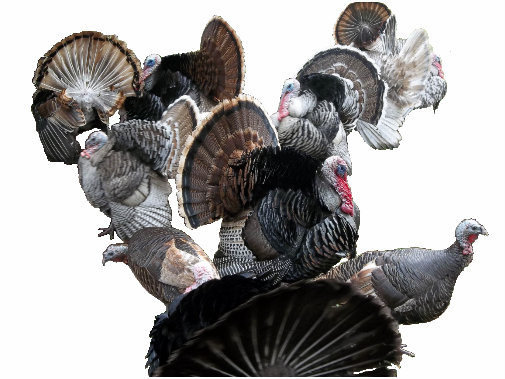
Invisible wall of Biological Security
The two most common subjects I get emailed is turkey illness and aggression.
So I have collected some information about your pet turkeys getting sick, signs, treatment options & prevention. Another page has some comments about NPIP certification.

First some rambling thoughts.
A few years back I inherited and read a 1911 veterinarian book. My itch, you might say, my curiosity was "What did people do for animal care before modern medicine?"
The answer was "Not much"
For example, for tetanus (Known then as lock-jaw) -the book stated "Place animal in a dark room and hope it does not die."
The poultry section was (and still is) very interesting if outdated, but one overriding factor seemed to link the most of the poultry diseases together as well as the prevention for those same diseases.
---
Nearly all the 1911 diseases in the vet book were related to people keeping their birds in filth. The book made some attempt at instructing veterinarians to teach people to clean the manure from their chicken or turkey coops.
I got to thinking that in 1911, while it was true there was more free ranging on farms; people in towns had their own back yard tiny coop that was probably never cleaned.
This line of thinking reminded me of the archaeological studies of ancient Native American turkey coops in Mexico and the south western United States (The study of Turkey manure that is thousands of years old)
Then I read about how the Romans used human waste to fertilize their crops resulting in the of spread parasites across their empire. And this modern day North Korean soldier infected with parasites for the same reason.
What ties these diverse event all together? Too much exposure to body waste products and the spread of parasites (worms)
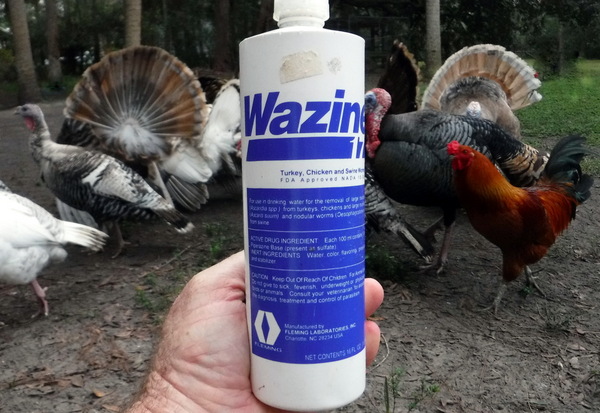
Wazine
The common "De-wormer" poultry/swine solution sold at the local feed store
Now in 2017, with modern medicine and modern schools, production turkey farms and You tube--the advice in that old book seems as valuable as ever.
And cleanliness is still near the top of the list for healthy and animals and people.
"Clean up that mess!" (or Free Range and/or use movable turkey coops)
-
We clean daily for the benefit of bird and garden
Biological Security is number one, but cleanliness is a close second
Best list of Turkey Diseases I have found at "The Chicken Vet" in the United Kingdom.
Another great United Kingdom site
And not to be left out, the Florida version (list and symptoms)
Best list of turkey medicines I have found (at Drugs.com)
Description of worms in Chickens-many crossover into turkeys.

A local poultry grower on Merritt Island has the following statement on his web page:
"We are a closed facility for the health and safety of our livestock. No tours are available"
The reason is Biological Security
Okay....
Prevention is the most important!
Biological Security
Before I ever owned my first turkey I read a fascinating article about the last wild cattle in England, the "Chillingham cattle" http://chillinghamwildcattle.com/
The article described the history, the possible relationship to the extinct aurochs of Europe; and the alpha male bulls fighting (and eventually losing) to keep breeding rights to the cows.
However as "Mad Cow disease" was sweeping Europe at that time- there were great concerns that the ancient herd would have to be euthanized. And so the second half of the article detailed the biological security rules of the park. (My first introduction to the concept)
And so when eventually I owned my own flock of turkeys, I was struck by the similarities of biological security to prevent the spread of diseases in poultry. Automobile tire treads and shoes were some the culprits of disease transmission
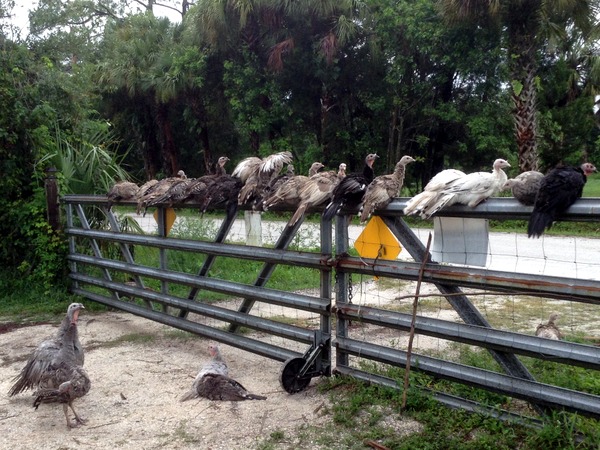
The birds ignoring the rules for biological security
I brought up biological security because it is logical, but others have followed the same menu; for example the Poultry hub in Australia mentions the following:
http://www.poultryhub.org/health/health-management/
The key principles of poultry health management are:
- Prevention of disease
- Early recognition of disease
- Early treatment of disease
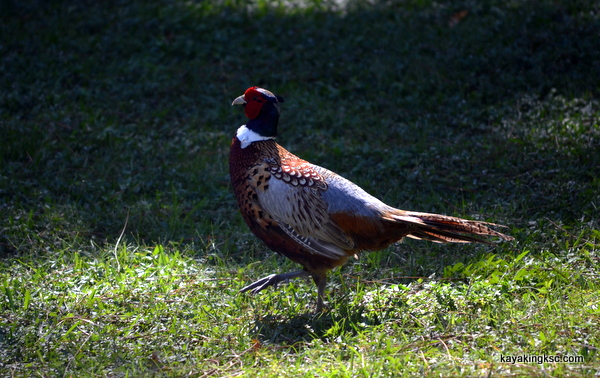
Biosecurity FAIL: This fellow just moved into our flock after having escaped from somewhere.
Note: This page is still under construction and will add sections as they are finished.
For those who need to know about NPIP certification:
My NPIP page (Opine & Whine page)
Types of poultry diseases, viruses, worms, and possible treatments for your pet turkeys.
http://www.merckvetmanual.com/poultry/helminthiasis/overview-of-helminthiasis-in-poultry

I have already covered turkey pox (carried by mosquitos) and although ugly has a high percentage of survival.
At the other end of the health problem is possible irradication.
How about Mycoplasma gallisepticum?
Vera sent me the paper below that has the following statement that makes me wince: "complete depopulation must be performed to break the cycle and prevent re-infection in subsequent flocks on the premises"
******!!******
From Vera Bundy's Bird Bordello (in Melbourne Florida)
321 - 723 - 2986 OR : 321 - 984 - 8114
Vera sent the following information on Mycoplasma Gallisepticum
Mycoplasma Gallisepticum - A Continuing Problem in Commercial Poultry
Gary D. Butcher, DVM, Ph.D.2
Mycoplasma gallisepticum (MG) infection in the commercial poultry industry is common in many parts of the world. Despite success in eliminating the disease in grand parent (GP) stock and turkeys, it persists in broiler breeders and broilers in many areas. There also continues to be a high incidence of the disease in commercial layers worldwide. The continued presence of MG in commercial poultry suggests that efforts at eradication were not highly successful. MG infection in the commercial poultry industry will likely continue and limiting losses will be the primary objective
M. gallisepticum infection is caused by an organism classified as a mycoplasma. This organism is similar to bacteria, but lacks a cell wall. This characteristic makes MG extremely fragile. They are easily killed by disinfectants, heat, sunlight, and other factors. They only remain viable in the environment, outside the chicken, for typically up to 3 days. For this reason, MG is fairly easy to eliminate on single-age, all-in all-out poultry farms. If a laying flock is infected, complete depopulation of the farm at the end of the laying cycle and providing down-time prior to reintroducing chickens will be successful in eliminating MG. However, complete depopulation must be performed to break the cycle and prevent re-infection in subsequent flocks on the premises.
When a chicken is infected with MG, the infection is of long duration. In the period after infection, the organism is present in the respiratory tissues in high levels and is shed into the environment and eggs. After several weeks, the level of infection and shed of the organism decreases. However, the infection persists in the flock indefinitely and the chickens may shed the organism intermittently, especially following a period of stress. This characteristic makes elimination of MG extremely difficult in multi-age breeder and laying complexes. As MG-clean pullets, raised in single-age farms and in isolation, are brought onto the complex, they are often exposed to the organism at probably the worst possible time-- at the onset of production. This cycle of spread continues in a complex with new flock introductions.
Efforts to reduce the adverse affects of the disease on breeders and egg-type layers in complexes have included use of antibiotics, killed vaccines, and live vaccines. These efforts have been successful in reducing drops in egg production following infection, maintaining levels of egg production throughout the cycle, reducing severity of concurrent respiratory diseases, controlling excess vaccine reactions, reducing sensitivity to air quality, limiting shed level and duration into the poultry house environment, and reducing egg transmission to broiler progeny. These efforts have not been successful, however, in eliminating infection and shed. More recently, live vaccines have become commercially available that do not spread from bird to bird, do not cause disease in turkeys, and cause a very mild and predictable reaction in pullets. These offer many advantages over the live vaccines used in the past. Most MG-positive breeder and egg-type layer complex managers administer these products to pullets prior to moving the MG-clean pullets onto infected complexes. Use of killed vaccines is common in some farms, especially broiler breeder complexes. While live vaccines are more commonly used in egg-type commercial layers. However, combinations of live and killed vaccines and antibiotics are used depending on local conditions. Use of antibiotics is most practical in broilers for controlling respiratory reaction.
M. gallisepticum is spread only short distances by the air-borne route. Where excellent biosecurity is practiced, there have been many instances where infection has not spread to adjacent houses within a complex. The disease is spread from farm to farm predominantly by movement of contaminated people, equipment and vehicles. Thus, basic biosecurity is the best means of preventing introduction of MG into layer and breeder complexes. Egg transmission to broiler progeny occurs at a low level from infected breeders, however, horizontal infection then readily occurs in broiler houses. Another potential means of transmission of MG that has not often been given much attention is the spread by wild birds and pet birds. Data have demonstrated that wild birds may become infected and shed MG. Likewise, the author in 1990 conducted a series of experiments and was able to infect, produce clinical disease, and isolate a classical MG field strain from budgerigars (parakeets). These findings further demonstrate the need to wild-bird-proof poultry houses when possible and to discourage company employees from ownership and/or contact with pet birds.
The decision to vaccinate or simply accept performance losses in commercial layers will depend on several factors. The strain of MG in a farm must be considered as some strains of MG are mild while others are highly virulent. House construction is a major factor in determining the severity of clinical disease. Open-sided houses and closed houses with excellent ventilation do not experience recognizable losses in performance, while the same layers in a closed-type house with poor ventilation will experience considerable performance losses. Thus, vaccination programs for MG must take into account the air quality where layers will be housed. Concurrent diseases such as coryza and infectious laryngotracheitis and the intensity of the live virus vaccination program, especially against IBV, NDV, ILT, are also variables to take into consideration.
MG infection in heavy breeders, almost without exception, requires intervention with vaccines and antibiotics. These breeders suffer significant loses and shed the organism to the progeny.
M. gallisepticum vaccination has been shown to reduce shed level and duration. Thus, if efforts are being made to eradicate MG on a commercial layer or breeder farm or reduce potential spread to neighboring non-infected farms, vaccination is suggested.
Affected broiler breeder flocks should be vaccinated prior to onset of infection and broilers managed and treated to reduce adverse of affects of MG.
It is unlikely MG will be eradicated from the commercial poultry industry in the coming years. However, through biosecurity programs and effective use of vaccines, losses can be reduced.
VACCINES ARE AVAILABLE @ JEFFERS VET SUPPLY – 1 – 800 – 533 - 3377
---------------------------------------------------------------------------------------------------
BUNDY'S BIRD BORDELLO
“ Raising Quality Poultry for Over 50 Years "
Member of: Society for The Preservation of Poultry Antiquities and Welsummer Club of North America
phone : 321 - 723 - 2986 OR : 321 - 984 - 8114

Agrosecurity --interesting warning
Roy's Farm in Bangladesh & diseases Interesting how turkeys are a world wide addiction!

Return Home from Turkey Diseases page
Contact us at Clovis636@aol.com
Do you need the perfect gift?
For pet lovers around the globe, "It's a Matter of Luck" is a collection of heart warming stories of horse rescues from the slaughterhouse.
Available on Amazon:
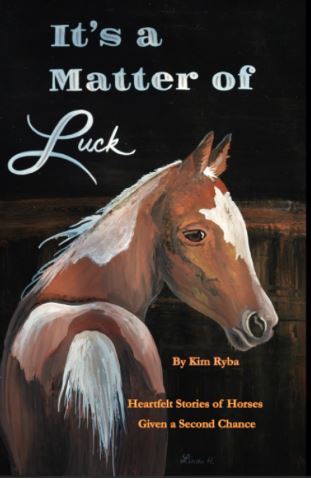
It's a Matter of Luck: Inspirational, Heartfelt Stories of Horses Given a Second Chance.
by Kim Ryba & Lina T. Lindgren
Warning: This book may cause your eyes to water -in a good way. (speaking from experience after reading it)
Please give Kim and Lina a heartfelt review on Amazon!

Author Bruce Ryba at Kennedy Space Center Launch Pad 39B & Artemis 1. "We are going to the Moon!"
Author's discussion (that's me) on You Tube of a book review on Amazon
My Facebook page Pet Turkeys You can always check in and say hello!
For the video versions of information, please check out my YouTube Channel (Turkeys, KSC, Flintknapping, dive stories etc.)
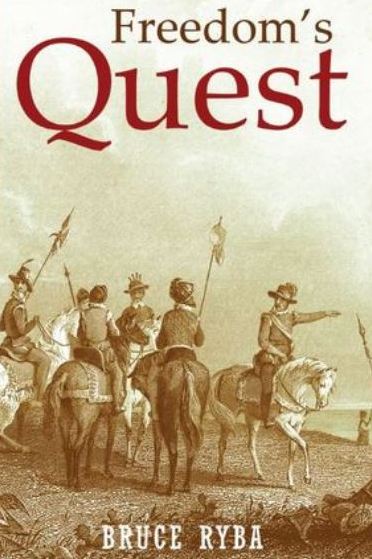
Book One of Florida History:
Freedoms Quest Struggle for the Northern Frontier and lost tales of old Florida
Fiction & language warning.
Available on Amazon
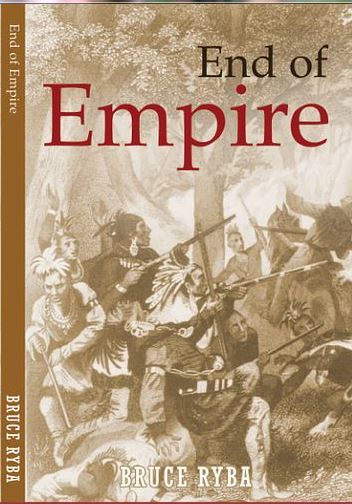
Desperate times call for bold action.
In a desperate move to retain Florida and protect the treasure-laden galleons on their dangerous return journey to Europe, the King of Spain issues a royal decree offering refuge to all English slaves who escape Florida and pick up a musket to defend the coquina walls of Saint Augustine.
In another bold gamble, the King offers refuge to the dissatisfied Indian nations of the southeast who will take up arms against the English.
Clans, traumatized by war and disease, cross the Spanish Frontier to settle the cattle-rich land and burned missions of Florida.
Follow the descendants of the conquistador Louis Castillo in remote Spanish Florida, a wildland swept by diseases, hurricanes, and northern invasions.
Book Two: Available on Amazon

